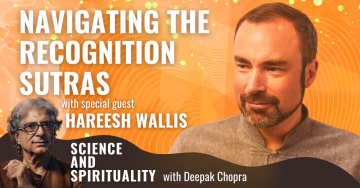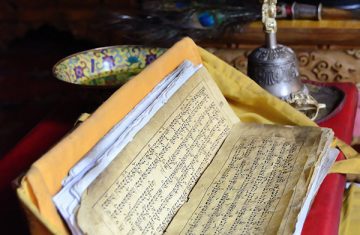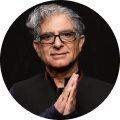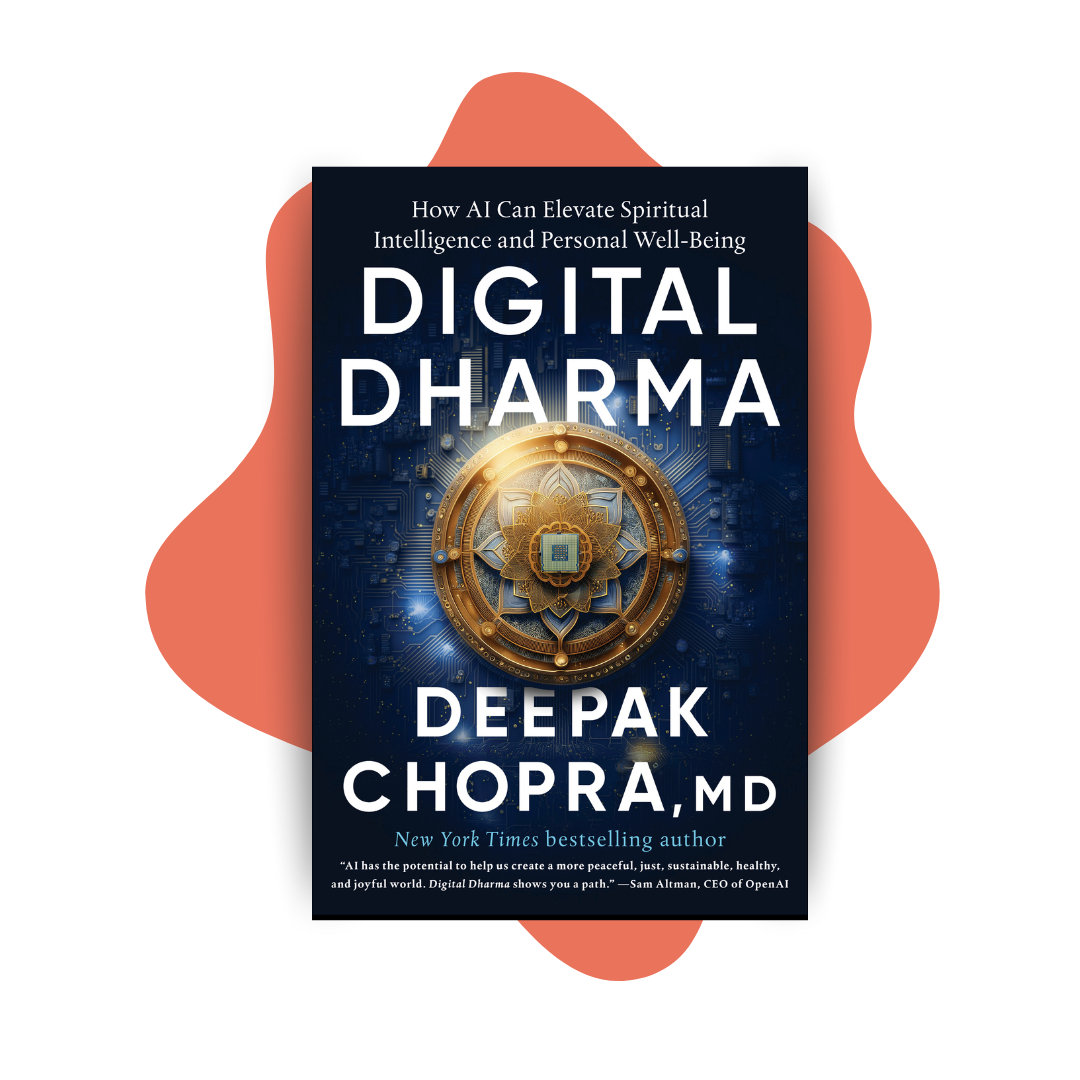Navigating The Recognition Sutras.

In this episode, join Deepak Chopra and Hareesh Wallis for a thought-provoking conversation that merges science and spirituality. With Hareesh’s deep understanding of Sanskrit and Deepak’s insatiable curiosity, together they explore the profound nature of consciousness and its relation to our perception of reality.
Discover how our thoughts, emotions, and experiences shape our sense of self and the world around us. Dive into the depths of consciousness, as Deepak and Hareesh guide us towards a deeper recognition of our true nature.
Through their insightful discussion, we are invited to embark on our own inner journey of self-discovery and understanding. As we navigate the realms of science and spirituality, we uncover the interconnectedness of all things and the transformative potential that lies within each of us.
Dr. Christopher Wallis (Hareesh) was introduced to meditation and yoga at 16. He is an academically trained scholar and traditionally trained practitioner with thirty years of experience. He is recognized worldwide as a lecturer, author, and translator of Indian philosophy and Sanskrit. He is internationally active as a spiritual teacher specializing in meditation, practical and Tantrik philosophy, and mantra science. He is the founder and director of a retreat center in Portugal, an online learning portal https://tantrailluminated.org, and offers guided tours in India. He is the author of Tantra Illuminated and The Recognition Sutras.
Listen to the podcast here
Navigating The Recognition Sutras
Exploring Tantra And The Sacred Sound Of OM With Deepak Chopra And Hareesh Wallis
We are continuing our series on science, spirituality, non-dualism, fundamental reality, or whatever you want to call it. I have a special guest. His name is Hareesh Wallis. Next to me is his book, The Recognition Sutras. This is a hardcover collector’s item, but the paperback is available online. You can check it out on Amazon. Here is his other book, Tantra Illuminated. I’ve been reading both of these books. I’m blown away by this gentleman’s erudition, scholarly work, understanding of the Sanskrit language, and a deep understanding of the nature of reality. Hareesh, thank you for joining me.
Thank you. It’s nice to be here.
Where are you now?
I’m in the beautiful hill country of Central Portugal, where I have a retreat center that’s opening. We meant to open it earlier, but COVID and all happened. We’re holding our first retreat here. We’re excited about that.
Deities And Higher Beings
You have beautiful paintings in the background and some amazing icons. Explain it to them. What are these symbols? What do they represent?
These are icons of Hindu deities, specifically tantric deities. The paintings are tantric goddesses. They’re esoteric goddesses, meaning they’re not part of the Hindu mainstream. I could tell you their names, but they’re semisecret goddesses. We also have Shiva and his Duction and Morty form, which is popular in South India. We have Ganesh, who’s a well-known icon.
In the tradition that I study, the tradition of tantra, they are considered icons of essence, meaning icons of our own essence nature, rather than separate beings or supernatural entities. They represent, embody, and express aspects of our own essence nature. There are many deities in tantra because there are many beautiful aspects to our essential nature. That’s what you see there in the background on the altar.
It’s beautifully expressed. I was a disciple of Maharishi Mahesh Yogi. I traveled with them, sat with him, sang, and heard his sermons. He used to explain them as aspects of our own self and symbolic representations of the divine essence, but with a particular motif, story, and theme, they were embodied in our physical and mental bodies.
We could become capable of the extraordinary superpowers of these if we did that through humility. Instead of worshiping them, invoking their essence, energy, form, story, and motif, they would incarnate and express themselves through us. Would you say that is a fair assessment of archetypes, deities, and higher beings, that they’re extensions of pure consciousness but with a particular theme, motif, or understanding?
In one way, I would say they are vibrations of one’s consciousness, like different flavors. As ice cream comes in many flavors, consciousness comes in all these flavors we call deities, gods, and goddesses. They’re icons of our own essence, nature, and aspects of our own true self if you want to call it that. They represent forces in the universe, not just within us. It’s not sufficient to consider them psychological archetypes in a Jungian sense.
They’re much more than that. For example, Lakshmi represents the principle of abundance and prosperity. She also represents the laws of economics or something greater than oneself. In this way, all the deities represent and embody aspects of the pattern of existence as well as aspects of our own inner nature. That’s an important principle of tantra. Everything outside is mirrored within, and everything within is mirrored outside. The deities must represent aspects of each of us and aspects of the wider universe.
Tweet: Everything outside is mirrored within, and everything within is mirrored outside.
That’s a great extension of what I said and beautifully said. I don’t want to dominate this conversation. I want to get the best from you, but Maharishi used to use the words Rishi, Davita, and Chandi in some heat. Rishi is the seer. Davita is the divine manifestation. As the seer, it projects itself as the scenery of the seer. Davita turned the world into whatever experiences, forms, and phenomena. It is all embodied in that pure infinite consciousness. Davita is a divine manifestation, as we know it, as perception, which creates the experience of the physical universe and perceptual activities. Divine activity is everything else if we understand what you’re teaching.
Getting To Know Hareesh Wallis
We’re going to discuss these themes if you’re willing. I’d like our audience to know about you. Where did you grow up? How did you get into Sanskrit? I want to ask you some questions that have agonized over for years about language. I’ll come to that later. Let’s get the audience to know about you. You look amazingly young to me for such a wise scholar. How old are you?
I’m 48.
I’m 74 and going on 75. Biologically, I don’t feel that, but I’m in great admiration of you as a scholar. Tell us about your life.
I grew up in the Pacific Northwest of the US. My life started to look a bit different from most Americans from about the age of seven because one of my parents took me to meet an Indian guru. He wanted to meet the Indian guru, my father, and they both ended up meeting him. My father took me along for the ride, as it were.
I met this Indian guru named Swami Muktananda, who made a big impression on me as a 7 or 8-year-old.
I had my first mystical experience, which was surprising because people started singing this mantra, Om Namah Shivaya, a traditional Indian mantra in the Sanskrit language. I have never heard Sanskrit before. I had never heard of the word guru before, let alone met one. It was all brand new. I was an American kid.
As soon as I heard this mantra for the first time, I closed my eyes spontaneously. I saw before me in my mind’s eye a vision of a beautiful, wise man and a beautiful being of pure wisdom, but he was made completely of scintillating, beautiful, sparkling blue light and seemed to have great wisdom and a long beard.
It’s fascinating to me because, at the time, I didn’t think about anything. I was a kid. I was like, “I saw a cool blue man.” Years later, I read in the primary sources of the Indian tradition that this is a traditional vision called the Neela Purusha, the blue person or the blue being, that you have this vision sometimes when you’re destined for that spiritual path.
It’s amazing because, for many years after that, I didn’t get involved in it. My mother became a faithful practitioner of Hindu spirituality. I thought it was weird. As teenagers do, I became a pre-teen and a teen. I was like, “This is too weird for me. Keep it out of sight, Mom.” When I was sixteen, I met another Indian female guru, Gurumayi. She made a big impression on me. This time, I was old enough to become interested in the practice.
It was several years later, after I had that childhood vision that I started to feel that this was something I wanted to be involved in. I started going to the meditation center in Seattle and becoming a practitioner. It wasn’t until some years later I wanted to take another deeper step and study this beautiful tradition full-time. That’s when I started academically studying.
In the old days of ancient India, you could join what was called the Guru Coola, and you could study spirituality and practice it in the same place. In the US, if you want to study full-time, you have to go to university. Luckily, there were a couple of professors of the Hindu religion I met who were also practitioners because I wasn’t interested in the dry, intellectual, purely academic study. I was interested in studying and applying to real life and having these experiences of awakening that the ancient scriptures talk about.
It’s lucky to meet a great scholar named Paul Mueller Ortega and several other great scholars. He is foremost amongst them. I was able to study with him and these others full-time, who were practitioners as well as academic professors of legitimate renown. That’s something that meant a lot to me. I was like, “How can I do this as a respectable career, as it were, but also be serious about the practice?” For a long time, I was on track to be a university professor. That changed because of the explosion of yoga worldwide. In the explosion of interest in yoga philosophy, I discovered I could be a freelance teacher and do as well or better for myself than being a university professor.
Even though I came close to being a university professor, I love the freedom of being a freelance teacher and teaching yoga teacher training all over the world, sharing these teachings of yoga philosophy and classical Indian spirituality with people who are practitioners but who want to go deep with their practice, not stay on that surface level. It’s a deeply rewarding career. I feel blessed because I get to talk about what I love the most, share it with people, and practice with people. That’s my career. It’s a blessed life. I have challenges as anyone does, but it’s extraordinary to live, study, and teach these things full-time.
I had the good fortune of being with Gurumayi many years ago. I have a fond memory of her gifting me a beautiful Shiva lingam. After I taught, I gave it to her ashram in Upstate New York. That memory is important to me. When did you get into Sanskrit as a language and study? How did you master Devanagari? It seems you know it better than most Indians.
It started at Gurumayi’s ashram in Upstate New York. I met a Sanskritist who was visiting there. I said, “Can you please teach me.” When I went to university, I took it further. My lust for knowledge was so great that I went to several different universities to make sure I was getting the best instruction from the best teachers.
I ended up in Rochester, New York, Berkeley, California, the UK, and Santa Barbara, California, studying with the best instructors and professors I could find. I was fortunate to have great teachers, both academically and spiritually. Sanskrit is a difficult language, but if you devote yourself to it full-time, it only takes a few years to master the language if you have some facility for languages. It’s about dedication. That’s become rare in modern India as well as in the West. It’s this dedication you need. It is one of those things that takes 10,000 hours to master. Sanskrit is like that, but if you love it like I did and do it, it doesn’t feel like work.

Recognition Sutras: Sanskrit is a difficult language, but if you devote yourself to it full-time, it only takes a few years to master it if you have some facility for languages.
Reading the script is fun, but it’s also important to understand the meanings that are being expressed and to expound those meanings to yourself and others. That’s the true reward because these ancient scriptures written in the Sanskrit language are profound and powerful that it’s said, and I believe it’s true that if you could understand all the way deep down and understand even one sentence from these ancient scriptures, it would be all you need for complete spiritual awakening and liberation. That’s that was enough motivation for me.
I see the Sanskrit behind you.
Chaitanya Mahatma means consciousness, which is the soul of the universe. You can translate it as the self of each being, which is indeed consciousness. The reality of selfhood is only consciousness. This is what I mean. You can contemplate a sentence like this for years because you can read it in several ways. Consciousness is the Atman, the soul of reality or the soul of the universe, but it also says that the only truth to the notion of selfhood, or I, is consciousness.
Tweet: The only truth to the notion of selfhood, or I, is consciousness.
The sutra is implying that it’s not all the things you think about yourself and constitute yourself. Your thoughts are not yourself. I am so-and-so. I have these good qualities and bad qualities. That is part of the contents of consciousness. Your selfhood is defined only by pure consciousness itself and the capacity to be aware. That is an infinitely profound statement that we could discuss for the next several hours.
Here’s something I have been struggling with. I’m going to be 75. I’m entering the fourth ashram of my own life. I spent the first 25 years becoming a doctor and the second 25 years, thanks to destiny, becoming famous and acquiring what people would call a fortune. The third 25 years, in a sense, hoping to give back. I hope I’ve done that through my nonprofit and other efforts exploring reality with scholars like you. Now, I enter the fourth phase.
My only intention for the world and for myself is seva, which is service, sadhana, spiritual practice, and Sangha, which is what we’re doing right now and sharing with the world, taking refuge in the Buddha, Dharma, and Sangha. Here’s what has bothered me, but now I’m seeing the light as my own awakening is happening. I believe it is clear in that. I’m not bamboozled by perceptual constructs, language, or naive realism in science. I am grounded in my being. I can see through the veil of ignorance.
Silence And Speech
One of the things that, along the way, I wanted to question you about because we say that highland silence is the highest and pure knowing. At least, that’s my experience when I go into silence. Traditionally, I take a week of silence every year and, sometimes, longer. I would join even if I was not there. I would go into silence.
For me, that was when I experienced bits and pieces of what you call revelation or awakening and glimpses of unbounded reality. We are all familiar with the great Indian sages taking one breath, as they say, and the revelations that come out of them. I don’t know how she or many others that we’ve known throughout the ages.
Rumi said, “God’s language is silence. Everything else is a poor translation.” For me, that was the means. I read stuff. That stuff is language. You’ve already come out from the silence. We also know the sequence of the unfoldment of silence. Para, Pashyanti, Madhyama, Vaikhari and how it unfolds. Silence unfolds into thought, speech, and action.
Language is a disruption of pure knowledge. I asked myself, “If we created language, are we disrupting the spontaneous knowing that comes from Samadhi or pure silence?” That troubled me a lot. For a time, I stopped reading altogether. I had the revelation that if all is consciousness and there is only consciousness, consciousness must have created language. It’s not we who created language. Consciousness created language.
Consciousness knows, or awareness knows itself as the knower and the process of knowing and that which is known. Maybe consciousness wants to explain itself through language. Consciousness created language, not humans. Consciousness created language because there’s only consciousness. Humans are one species-specific expression of consciousness. I became comfortable with the idea of language as a means to enlightenment. You spoke about the blue being. You use the word Neela Purusha. Is this the language of Saraswati, the goddess of wisdom?
You raise an important point because it’s true that you cannot think your way to enlightenment. The study of philosophy as such does not avail a seeker of the path of awakening. However, here’s what the Indian tradition has to say about this, which is remarkable. It’s not only the Indian tradition. We find this teaching in others. It’s the idea that somebody who has already awakened when they utter words that arise spontaneously from that awakened state, the contemplation of those words helps others glimpse, recognize, and embody that same awakened state.

Recognition Sutras: You cannot think your way to enlightenment. The study of philosophy as such does not avail a seeker of the path of awakening.
Such words are not mere philosophizing, intellectualism, or speculation. They are spontaneous, ecstatic expressions of the awake mode of existence. They have they’re impregnated with this unique power to take us beyond thought. That’s what’s amazing about tantric philosophy in particular. It’s said to be the thorn you use to pluck out another thorn. This is an old proverb like, “If you get a thorn stuck in your foot, you use another thorn to pluck it out.” In the same way, if you are studying the language and thoughts of the awakened ones, that takes you beyond thought altogether. This is a different language in that sense. It’s that fundamental principle. You cited the four levels of speech earlier.
You would do a good job of explaining these four levels of speech.
They’re explained in more depth in my book. The most superficial level of speech is the one that you’re reading now, readers. The words that I’m articulating with my vocal tract in the English language are the most superficial layer of speech, called Vaikhari in Sanskrit. Whether it’s Sanskrit or English, it doesn’t matter. It’s still the most superficial level because words are reductionistic and inherently dualistic.
There’s a deeper level, which is this Madhyama. We can take these words, especially if we’re taking the words of the awakened ones. We can take them inside, marinate in them, and soak our minds in these words. Even if we don’t understand them, we turn these words over in our minds. You take one of these sutras, and you marinate in it. It starts to work within you. It has its own power because it arose spontaneously from the consciousness of a fully awakened being.
After a while, at that level, it goes deeper. It goes to this Pashyanti level. The Pashyanti level is almost like the level of dreams and the subconscious, but it’s also the level of deeply internalized knowledge. When it reaches that level, it starts to inform your vision of reality. Pashyanti means viewing or visioning. It starts to shape the way you’re experiencing reality.
Here’s the important part. You let go of the original teaching altogether because it has set you on a trajectory or a course that lands you in reality itself. If we cling to the teaching, no matter how sublime, we don’t get beyond conceptualization. Instead, we let it point our ship or sailboat in one metaphor, and we go in that direction. We go beyond the teaching itself to the direct experience that caused the teaching to be articulated in the first place.
That’s this ultimate level, this Paravāc, non-conceptual, direct experience of the fundamental nature of reality, which gives rise to this expression of these beautiful teachings in the first place. This holds us a fascinating possibility because most people think religion is about believing the words of a prophet or a messiah. It’s a completely different orientation. We take the words of the masters, and we seek to discover within ourselves the state of consciousness that caused them to utter those words in the first place. That’s a different project or endeavor. It’s not religion. It’s spirituality.
Para is pure knowing. Could you say Para is pure knowing?
Paravāc could be translated as the supreme word, like a capital W word, but it means the deep structure of reality, the inherent fundamental nature of reality prior to thought, which makes all thoughts possible. Paravāc is impossible to translate. It’s like the Greek concept of logos. It is parallel to that.
Maharishi Mahesh, my guru, was the dentist of the Shankara chariot tradition. Through him, I encountered the teachings and the knowledge of Lakshman Joo first, and this whole arena moved me to understand a little bit about Kashmir and Shivism, reading the works of translations of the works of Abhinavagupta.
Recognition Sutras
Two sutras stuck out to me in a way that transformed me. One was to meditate on your body as the universe and have the nature of awareness. That was the first time I heard that. It rang true to me. The other was you and the universe are aware. That’s all you need to know. I am interested in Shiva sutras and your work on recognition sutras. Tell me what the recognition sutras are. What are we talking about? What is the recognition sutra? What’s the history? What’s the background? Why did you write this book?
I will explain that. First, I want to comment on this extraordinary synchronicity. If I could zoom the camera more, you would see that this sutra here is Drishyam Shri Ram, which is the sutra you cited as taught to you by Maharishi Mahesh Yogi. The universe is your body. Your body is the universe. All that is perceptible in this universe constitutes the body of consciousness. You are consciousness. These two sutras are the two that your guru shared with you.

Recognition Sutras: The universe is your body. Your body is the universe. All that is perceptible in this universe constitutes the body of consciousness. You are consciousness.
It is a sign that you’re on the right track. The synchronicity itself is an omen from the divine that we’re on the right path. Tell me about the recognition sutras and the name. What are the recognition sutras? Let’s go there.
The tradition of classical tantra, also known as tantric Shaivism, was widespread throughout all of India and Southeast Asia at one time but was wiped away by the conquests and colonialism. Before all that, it was flourishing everywhere, not in Kashmir. We have this misnomer, Kashmir Shaivism, which implies it was only flourishing in Kashmir. It was everywhere in India.
In Kashmir, we had these incredible authors, writers, and philosophers. Many years ago, in the valley of Kashmir, there was this efflorescence of great thinkers, practitioners, sages, and masters. It was considered a golden era for the tradition in the Deep South, Kerala, Tamil Nadu, and Karnataka. The author of the recognition sutras lived in Kashmir many years ago. He was at the peak of his career in 1021. His name was the King of Contentment. That was Kshemaraja, the King of Contentment. He was the foremost disciple of the great Abhinavagupta, who was the greatest tantric master of all time.
Kshemaraja, this great scholar sage, composed the recognition sutras. There was already a tradition at that time of the philosophy of recognition or Pratyabhijna in Sanskrit. The philosophy of recognition means the philosophy of how to recognize yourself as the divine, and you are God, and not just you, all beings. All beings are direct expressions and manifestations of the one infinite divine intelligence which gives rise to the whole pattern of existence.
The recognition school sought to teach people how to recognize themselves as divine, which is a different experience from the experience most people have, even if they’ve heard this teaching. You are God in their yoga studio. Most people experience things like, “I am a pathetic little nothing in this big, wide, scary universe.” It’s because they are identified with their conditioning, body, mind, thoughts, and cultural conditioning. The recognition school teaches us how to release that identification without any denialism or spiritual bypassing, to release that identification and rest in our true, deepest, innermost nature as divine consciousness.
Many people considered this philosophy abstruse at the time. It’s subtle and difficult. Kshemaraja wrote these sutras that you have displayed there, including the recognition sutras, to make it easier for people. He composed twenty sutras summarizing the recognition philosophy. These sutras are luminous. They’re magical, powerful, and impactful. They do come from this deepest state of awakening that he embodied.
If you hear one of the sutras by itself, you might not realize its power at first. For example, sutra number one of the recognition sutras is Citih Svatantra Visva Siddhi Hetuh, which means consciousness is free and independent in its real nature. It is the cause of the manifestation or the magic of the universe. It’s profound. You don’t realize the full depth of its profundity until you go through a spiritual process of internalizing the wisdom that it points to because the wisdom it points to is wordless. It’s non-conceptual, but we use words to penetrate the non-conceptual. How do you do that? What are the steps? That’s what’s in the book.
Tweet: Consciousness is free and independent in its real nature. It is the cause of the manifestation or the magic of the universe.
Kshemaraja explains his own sutra. He gives a commentary on his own sutra. I will explain it further. I wrote the commentary on the commentary, as it were, but it’s all laid out in a way that’s accessible for a modern reader. I wanted to translate this book most of all because it was written as a primer, meaning it was written as an introductory text to map the whole spiritual path in twenty sutras and twenty aphorisms to map the whole spiritual path from beginning to end, and it does. It’s extraordinary. It’s the most high-octane work, meaning the ratio of signal to noise is incredible. There’s not a single wasted word.
When you read this book, you’re reading a map of the whole spiritual path, how consciousness manifests a universe of experience for itself, gets lost within that universe, forgets itself temporarily, becomes contracted, remembers itself, and integrates that realization of its true nature into an embodied experience. It’s the whole map. It’s wonderful to have this in a readable form.
I have to admit. This has been translated once before. I did my translation, but it was in a form that was not readable to most people. It’s written in mid-20th century Indian English, which many Indian readers are fine with, but Westerners cannot wrap their heads around. This is a modern English explanation of the work. I also cite a lot of parallel passages, meaning passages from related scriptures that help us understand the base text more fully. That’s why, even though the original scripture is only 50 pages, my book is 400 pages. You need that much to explain it clearly and simply. I know you’ve read the whole thing or most of it anyway.
Yes, more than once. As I heard you explain the first sutra, the insight I had is that consciousness is intrinsically free of its modifications, which we call Vrittis, which are sensations, perceptions, images, feelings, and thoughts that we conceptualize as mind, body, and universe. These are on-off evanescent fluctuations of consciousness that ultimately create the appearance not only of the subtle body and the physical body but also of the physical universe or the appearance. In a sense, consciousness is modifying itself into these appearances, which have no fundamental reality and consciousness, even as it modifies itself as those. When we identify with them, we become the prisoner of the veil of ignorance or Maya. Is that a fair assessment of what you said?
It’s not only a fair assessment but beautifully and accurately said. That’s it. What this tradition is teaching us is that most people think, “I need to change something about my life or situation to feel free.” That’s a good idea to change something about your life, but that’s not required to feel free because freedom is intrinsic to consciousness itself.
If any of us learns to release identification with the thoughts, feelings, and images that appear in consciousness, images like body and world, it comes to rest in our true nature. You discover it’s intrinsically free and even has an intrinsic capacity for joy, the ability to simply enjoy being and enjoy existence no matter what’s happening.
We know this is true because people who spiritually awaken in this way experience freedom and joy, even in a prison cell. If you can experience total freedom and joy there, you can experience it whatever your life is. In this tradition, we say no. First, realize yourself and your true nature, and let whatever changes naturally happen in your life. As a result of that realization, let them all unfold. Most people are going about it all wrong, trying to change something in their life. They’re like, “I need more money in my bank account. I need more lovers. I need more likes on Facebook, and I’ll be happy.”
That is a no-win scenario because it’s never worked for anyone, ever. It’s this attempt to manipulate your environment and experience that reinforces the false sense of selfhood and control instead of relaxing into the level of your being that’s already free and joyful. That’s the key to the teaching. You don’t have to manufacture peace of mind. You learn to relax and slip out of conditioned thought into the level of your being that’s already completely joyful and peaceful.

Recognition Sutras: You don’t have to manufacture peace of mind. You learn to relax and slip out of conditioned thought into the level of your being that’s already completely joyful and peaceful.
Most of your apparent problems evaporate. You’re like, “I was making these problems in my own mind. I was labeling things as problems that don’t need to be labeled.” Whatever real problems remain, the solutions reveal themselves as part of the natural flow of life. It’s a different paradigm of existence. The irony is that it’s available to everyone, and few people have discovered it. There’s a cultural conspiracy because our economy is driven by consumption.
The only way to get everyone to keep consuming is to give them the message. You’ll finally be happy when you consume enough experiences and material goods. That myth has to be perpetuated to keep the economy running, which is a tragedy because it requires the concealment of the key to happiness and joy in life. We’ll have to find another way as a species, sooner or later, because we can’t keep on with a system whose primary requirement is that the secrets to happiness and joy in life are concealed from most people most of the time.
Mantra, Yantra, Tantra
We’re close to running out of time on our first session. I hope you’ll join me for many more so we can explore each of these sutras in depth and start again next time with the first sutra because we didn’t go deeply into it, although we addressed it. Before I let you go, and we have only less than ten minutes because otherwise, we won’t be able to post this for technical reasons, I’m going to ask you to briefly define certain words that are germane to everything that you’re teaching about mantra, yantra, and Tantra. They are part of the ritual of tantra. We can stop after that.
Mantra, in the West, is often confused with making affirmation. Traditionally, a mantra is always in the Sanskrit language. This is something most people don’t understand. The whole point of a mantra is not what it means but rather its inherent vibration. These mantras or sacred utterances are said to have spontaneously arisen in deep meditation.
That is to say that they were revealed to the great masters and sages of meditation and yoga. They have been passed down through centuries and even millennia in many cases. It’s said that every person who repeats a mantra with love, devotion, focus, and dedication infuses that energy into the mantra and passes on the mantra with some of that energy.
These mantras that have been repeated for centuries with so much dedication and love come to us with that love and power of dedication infused in them. If someone were to translate a mantra and repeat it in English, they would lose all of that because a mantra is not a prayer. That’s the key. It’s not a thought even. It’s a condensed vibration of consciousness. Mantras are key for the path of tantra, which utilizes these sound vibrations in many different ways that we can talk about later.
Corresponding to mantras, we have yantra. These are sacred geometry and mystical diagrams. What’s interesting, and a lot of people don’t know this, is that each yantra is a mantra in visual form. There’s this fascinating field. I’m sure you know about cymatics, which is the science of expressing sound in visual patterns. If you put sand on a metal plate and vibrate tones underneath it, it spontaneously organizes itself into geometric patterns that look like mandalas or yantras.
These diagrams are considered powerful visual representations of fundamental pulsations of consciousness that help us access deeper levels of our own inner nature. A traditional practice is to gaze at a yantra, unmoving, and repeat the corresponding mantra. You must make sure that you have the mantra that matches the yantra. This is why people call these practices pre-modern technologies that we use to hack consciousness. That’s not exaggerated terminology at all. They are technologies.
Why do these words all sound the same, mantra, yantra, and tantra? The suffix tra is an instrumental suffix in Sanskrit. A mantra is a tool for the mind mantra that refines, empowers, clarifies, and purifies the mind. A yantra is a corresponding tool for channeling energy because yan comes from yan to channel.
Tantra has many meanings, but one of its meanings is a scripture. A tantric scripture is called a tantra, and that means a tool for expansion. Tan is to expand, and tra is a tool. It’s a tool for expanding awareness, consciousness, and experience of reality. Each of these scriptures is a tool for expansion. Tantra also means the whole system. The whole system is this radical, innovative tool for expansion. It’s still relevant and cutting edge in our time, as anyone who reads this stuff will discover.
Tantra is the whole body of knowledge.
Tantra can mean the system. In the early days, it was still a secret. People would say, “Have you heard of the tantra system for liberating consciousness?”
This is like the Gnostic seers, the secret knowledge. Before I let you go, is Sri Yantra the Yantra for Om because that is the conversation in the ecosystem?
Sri Yantra is the visual representation of fifteen fifteen-syllable mantras that are highly secret, but it’s the Sri Vidya mantra. I’m not permitted to say that in this context.
Is Om its own yantra? The OM looks like a beautiful, symbolic visual representation.
Om is considered the praṇava. It’s the fundamental pulsation of reality. You might even almost say it’s the vibration that pervades the whole universe from the Big Bang, which is analogous to Om. It’s the fundamental tonic. It doesn’t have its own yantra because the whole universe is the yantra of Om. When Om gets joined to a longer mantra like the Mahamrityunjay Mantra, there is a yantra that goes with it.
Your name is Hareesh. What does it mean?
This name was given to me by Swami Mukhtar Ananda when I was a child. There are two meanings. He gave the meaning. It’s Remover of Sorrows. Hareesh also means Vishnu and Shiva in one. Haree and Isha.
Important Links
About Dr. Christopher Wallis
Dr. Christopher Wallis (Hareesh) was introduced to meditation and yoga at 16. He is an academically trained scholar and traditionally trained practitioner with thirty years of experience. He is recognized worldwide as a lecturer, author, and translator of Indian philosophy and Sanskrit. He is internationally active as a spiritual teacher specializing in meditation, practical and Tantrik philosophy, and mantra science. He is the founder and director of a retreat center in Portugal, an online learning portal https://tantrailluminated.org, and offers guided tours in India. He is the author of Tantra Illuminated and The Recognition Sutras.

